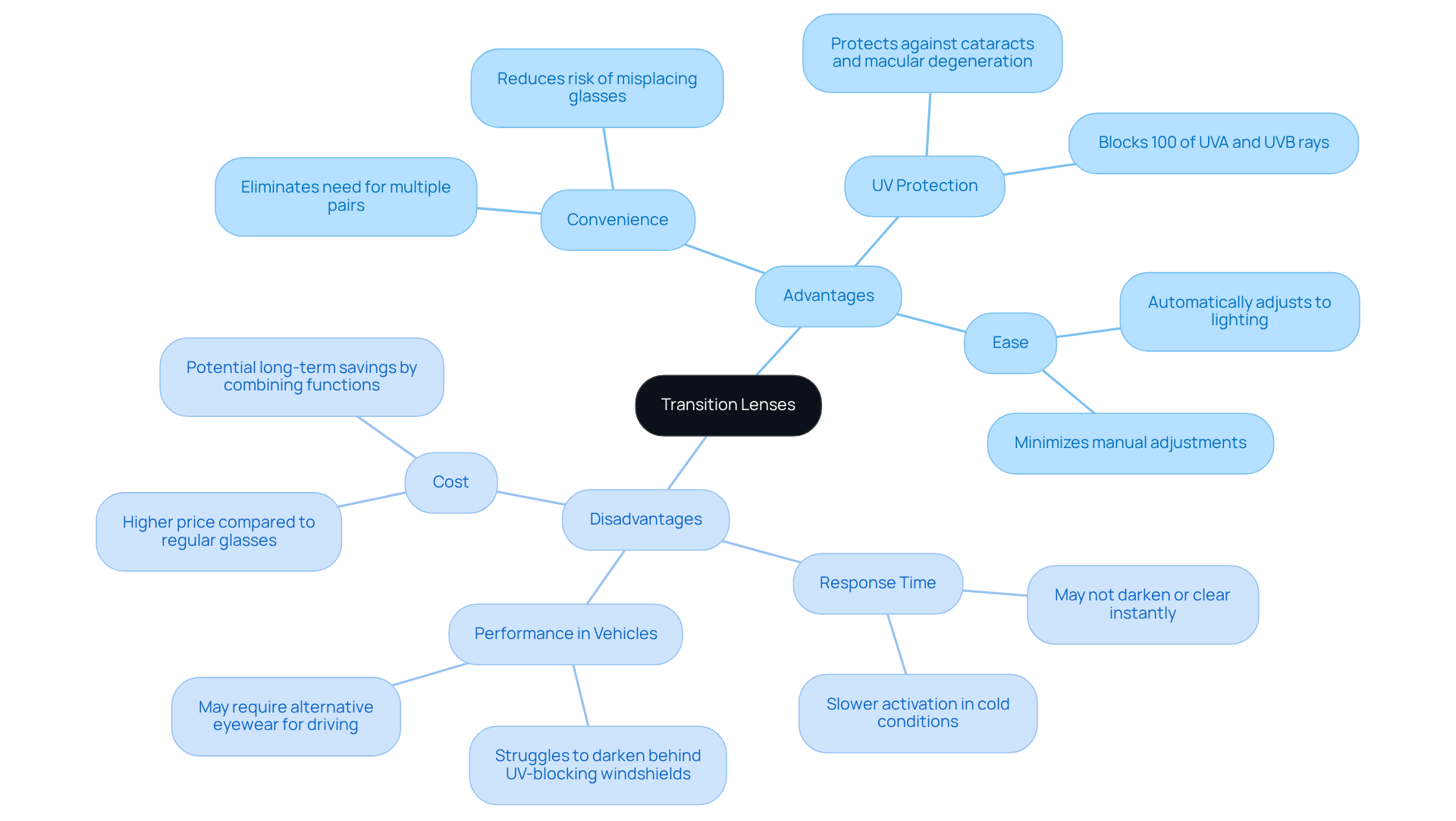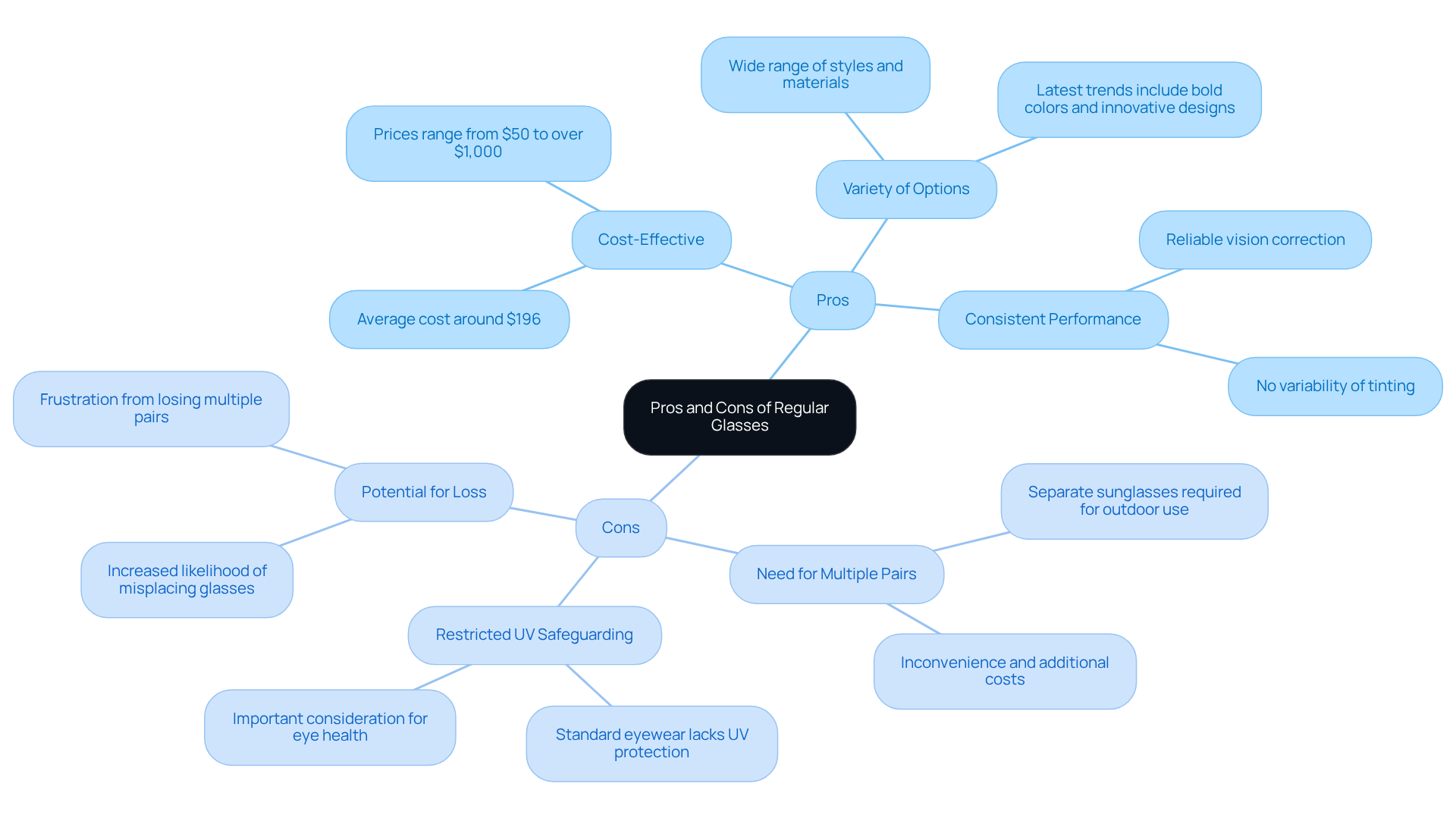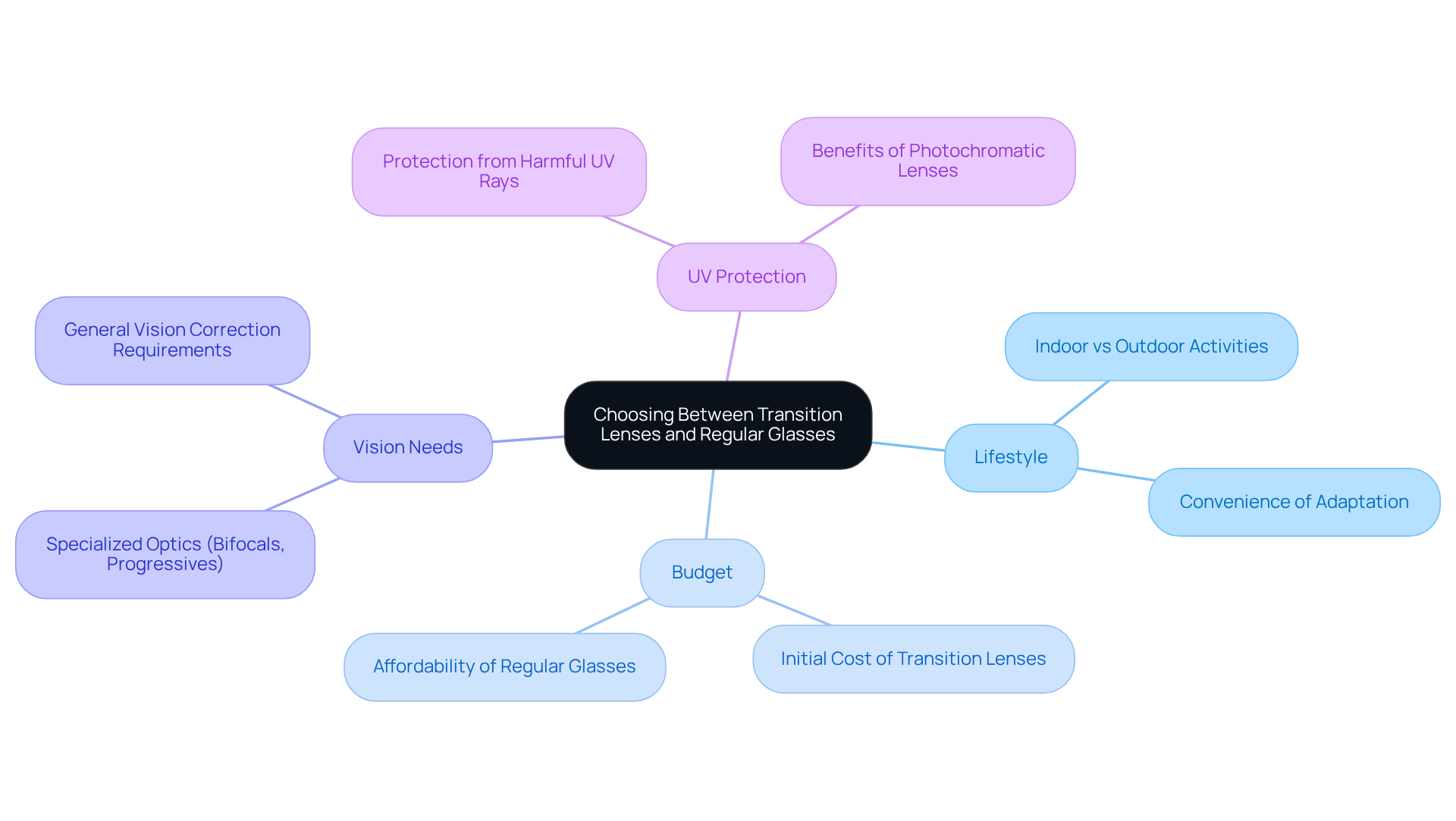Posted by: Northwest Eye in General on November 13, 2025
Introduction
Transition lenses have become a popular choice for those of you seeking convenience and eye protection in different light conditions. We understand that navigating between indoor and outdoor environments can be challenging, and these innovative lenses automatically adjust their tint, offering a seamless experience.
However, as the eyewear market continues to grow, it’s common to wonder: do the benefits of transition lenses truly outweigh their drawbacks when compared to traditional glasses? This article aims to explore the key features, advantages, and limitations of both options. Our goal is to guide you in making an informed decision that aligns with your lifestyle and vision needs.
Understanding Transition Lenses and Regular Glasses
Transition optics, often known as photochromic optics, are designed with your comfort in mind. They automatically adjust their tint based on changing light conditions, darkening in response to UV light to protect your eyes from bright sunlight. When you step indoors, they revert to a clear state, enhancing your visual comfort and convenience. This is especially beneficial for those who frequently move between indoor and outdoor environments. In contrast, regular glasses remain static in tint and primarily focus on vision correction, though they may include specialized coatings for anti-reflective properties or blue light filtering.
We understand that many consumers are looking for eyewear that meets multiple needs. Recent studies indicate that around 30% of people are currently using photochromic eyewear, reflecting a growing trend towards multifunctional glasses. Optometrists emphasize the importance of these optical devices, noting their exceptional UV defense. This is crucial, considering that over 20 million individuals worldwide are affected by cataracts, a condition exacerbated by UV exposure. Additionally, advancements in photochromic technology have led to quicker adaptation periods and improved clarity, making variable-tinted glasses an even more appealing choice.
Practical examples highlight the benefits of adaptive eyewear. Outdoor enthusiasts appreciate how smoothly these lenses adjust to varying light conditions, while individuals with light sensitivity find them essential for reducing glare. This combination of functionality and comfort in adjustable eyewear raises the question: are transition lenses worth it for anyone seeking both style and practicality in their glasses? We are here to help you find the right eyewear that suits your lifestyle and needs.

Pros and Cons of Transition Lenses
Advantages of Transition Lenses:
- Convenience: We understand how important it is to have the right eyewear for different environments. You might wonder, are transition lenses worth it, as they beautifully combine the functionality of regular glasses and sunglasses, eliminating the need to juggle multiple pairs. This is especially helpful for those who frequently move between indoor and outdoor settings, reducing the risk of misplacing sunglasses. By wearing photochromic eyewear throughout the day, you can also lower the chance of misplacing your glasses.
- UV Protection: Your eye health is vital, and these lenses provide ongoing UV protection, which is essential for avoiding serious issues like cataracts and macular degeneration. Research indicates that 20 percent of cataract cases are linked to prolonged UV exposure, making the protective features of adaptive eyewear increasingly significant. Experts agree that the quick adjustment of these lenses to sunlight plays a crucial role in safeguarding your eyes.
- Ease: Many users appreciate the ease of adaptive eyewear, as they automatically adjust to different lighting situations. This adaptability minimizes the need for manual adjustments, allowing for a seamless visual experience. However, it’s common to feel a bit of discomfort in especially chilly conditions, as the response time may be slower.
Disadvantages of Transition Lenses:
- Response Time: One concern that some users have is the response time; transition lenses may not darken or clear instantly. This can be inconvenient in situations with rapidly changing light. For example, in bright, cold conditions, activation may be slower, which can lead to discomfort.
- Performance in Vehicles: It’s important to note that transition eyewear often struggles to darken effectively in cars due to the UV-blocking features of windshields. This limitation can compromise their effectiveness for drivers, so you might want to consider alternative eyewear solutions for driving.
- Cost: Transition glasses typically come with a higher price tag compared to regular spectacles. We understand that this cost factor may deter some consumers, especially those who are budget-conscious. When considering whether are transition lenses worth it, it’s important to note that investing in photochromic eyewear can save you money over time by eliminating the need to buy separate sunglasses.
In summary, while photochromic glasses offer substantial advantages in terms of convenience and UV protection, it’s essential to weigh these benefits against their limitations, particularly regarding response time and effectiveness in vehicles, to consider if are transition lenses worth it. Additionally, the variety of color choices available for adaptive eyewear allows for personalization, catering to your unique style preferences. We are here to help you through this process and ensure you find the best eyewear for your needs.

Pros and Cons of Regular Glasses
Pros of Regular Glasses:
- Cost-Effective: We understand that budget is a significant concern for many. Regular glasses are generally less expensive than transition lenses, with the average cost of prescription glasses in the U.S. being around $196. Prices can range from $50 to over $1,000, depending on style and features. This makes them a budget-friendly option for many.
- Variety of Options: It’s great to know that regular glasses come in a wide range of styles, materials, and optical types. This allows for personalized choices based on both fashion and function. The latest trends in 2025 showcase bold colors and innovative designs, appealing to diverse consumer preferences.
- Consistent Performance: Regular eyewear offers reliable vision correction without the variability of tinting. This ensures clarity in all lighting conditions, which can be a comforting thought for those who rely on their glasses daily.
Cons of Regular Glasses:
- Need for Multiple Pairs: We understand that having to purchase separate sunglasses for outdoor use can be inconvenient and costly. It’s common to feel overwhelmed by the need for multiple pairs.
- Restricted UV Safeguarding: Unless explicitly processed, standard eyewear does not provide the same degree of UV shielding as adaptive eyewear. This is an important consideration for your eye health.
- Potential for Loss: Having multiple pairs increases the likelihood of misplacing or losing one of them, which can lead to frustration. We know how annoying that can be.
In summary, while regular spectacles are a budget-friendly and adaptable option, they do come with specific disadvantages. It’s essential to take these into account when assessing your eyewear alternatives. Remember, we are here to help you through this process.

Choosing Between Transition Lenses and Regular Glasses
When you’re deciding between transition lenses and regular glasses, it’s important to consider a few key factors that can really impact your daily life:
- Lifestyle: We understand that many of you move between indoor and outdoor environments throughout the day. Many people wonder, are transition lenses worth it for their ability to adapt to changing light conditions and provide wonderful convenience? However, if you find yourself mostly indoors or engaging in specific outdoor activities that require sunglasses, standard eyewear might be the better fit for you.
- Budget: It’s essential to think about your eyewear budget. Transition lenses often come with a higher initial cost, while regular glasses can be a more budget-friendly option, giving you flexibility in your spending.
- Vision Needs: Your unique vision correction requirements are crucial. If you need specialized optics, like bifocals or progressives, make sure that your choice can effectively meet those needs.
- UV Protection: If protecting your eyes from harmful UV rays is a priority for you, photochromatic lenses provide an added layer of defense that standard glasses may not offer.
Ultimately, when considering your personal preferences, lifestyle, and visual health needs, you may wonder, are transition lenses worth it compared to regular glasses? Remember, we are here to help you through this process and ensure you find the best option for your eyes.

Conclusion
Transition lenses provide a wonderful blend of functionality and convenience, making them a great choice for those navigating different lighting conditions throughout their day. We understand how important it is to have eyewear that adapts to your needs. These lenses automatically adjust to light changes, enhancing visual comfort while offering essential UV protection—something that’s increasingly vital for your eye health. On the other hand, regular glasses, while budget-friendly and consistent, can be a hassle since they require carrying multiple pairs for various settings.
This article highlights the significant advantages of transition lenses, such as their convenience and protective features, while also acknowledging their limitations, like response time and performance in vehicles. Regular glasses are presented as a cost-effective alternative, but they don’t offer the adaptive benefits that transition lenses do. Ultimately, your choice between these options should reflect your personal lifestyle, budget considerations, and specific vision needs.
As you reflect on these insights, it’s crucial to carefully weigh the benefits of adaptive eyewear against their drawbacks. We know that as consumers become more aware of the importance of UV protection and convenience, transition lenses may be a worthwhile investment for those frequently moving between indoor and outdoor environments. For anyone considering their eyewear options, understanding these factors can lead to a more informed decision that aligns with both your lifestyle and visual health requirements. Remember, we are here to help you through this process.
Frequently Asked Questions
What are transition lenses?
Transition lenses, also known as photochromic optics, are designed to automatically adjust their tint based on light conditions. They darken in response to UV light to protect your eyes from bright sunlight and revert to a clear state indoors.
How do transition lenses differ from regular glasses?
Transition lenses change tint based on light exposure, enhancing visual comfort in varying environments, while regular glasses remain static in tint and primarily focus on vision correction. Regular glasses may have specialized coatings but do not adjust to light changes.
What percentage of people are using photochromic eyewear?
Recent studies indicate that around 30% of people are currently using photochromic eyewear, reflecting a growing trend towards multifunctional glasses.
Why are optometrists emphasizing the importance of transition lenses?
Optometrists highlight transition lenses for their exceptional UV defense, which is crucial for eye health, especially since over 20 million individuals worldwide are affected by cataracts, a condition worsened by UV exposure.
What advancements have been made in photochromic technology?
Advancements in photochromic technology have led to quicker adaptation periods and improved clarity, making variable-tinted glasses more appealing.
Who benefits from using transition lenses?
Outdoor enthusiasts benefit from the smooth adjustment of these lenses to varying light conditions, while individuals with light sensitivity find them essential for reducing glare.
Are transition lenses a good choice for those seeking style and practicality?
Transition lenses offer a combination of functionality and comfort, making them a worthwhile option for anyone looking for stylish and practical eyewear.






